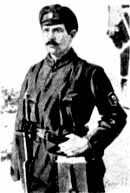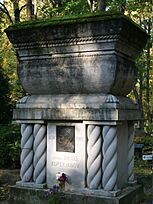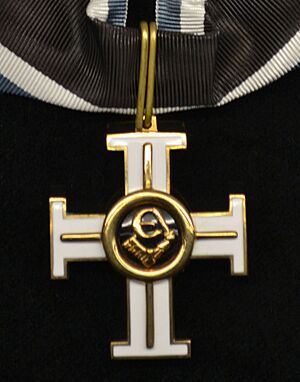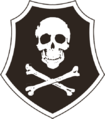Julius Kuperjanov facts for kids
Quick facts for kids
Julius Kuperjanov
|
|
|---|---|
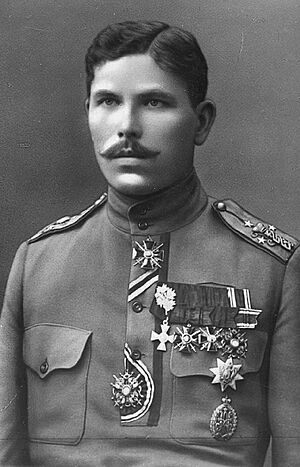
Julius Kuperjanov
|
|
| Born | 11 October 1894 Lyokhovo, Dukhnovo parish, Pskov Governorate, Russian Empire |
| Died | 2 February 1919 (aged 24) Tartu, Estonia |
| Place of burial |
Raadi cemetery
|
| Allegiance | |
| Service/ |
Army |
| Years of service | 1914–1917 Imperial Russian Army 1918-1919 Estonian Army |
| Rank | Lieutenant |
| Unit | Tartumaa Partisan Battalion |
| Battles/wars | World War I Estonian War of Independence
|
| Awards | Order of St. Anna II, III, IV degree Cross of St. George IV degree Order of Vladimir IV degree Order of Stanislav II, III degree Cross of Liberty (Estonia) (VR I/2, VR II/2 and II/3; posthumously) |
| Spouse(s) |
Alice Johanson
(m. 1918) |
Julius Kuperjanov (born October 11, 1894 – died February 2, 1919) was an Estonian military officer. He is famous in Estonia for being one of the heroes who helped free the city of Tartu. He was also the leader of the Tartumaa Partisan Battalion, a special fighting group. After his death, he was given the Cross of Liberty, a very important Estonian award.
Contents
Life Story of Julius Kuperjanov
Early Years and Education
Julius Kuperjanov was born on October 11, 1894, in Pskov, Russia. His parents, Taniel and Liisi Kuperjanov, were Estonians who had moved to Russia for work. Because they lived in Russia, their family name became a bit "russified," meaning it sounded more Russian.
In 1904, when Julius was about 10 years old, his family moved back to Estonia. They settled in the Tartu area. Julius went to a local school in Sipel Vana-Kuuste for five years. After that, in 1910, he joined the Tartu Teachers' Seminar. This was a school where he trained to become a teacher.
He finished his studies in 1914. He then asked to work as a teacher in the village of Kambja. Many teachers were being called to fight in World War I, so schools needed new staff. On February 26, 1918, Julius Kuperjanov married Alice Johanson.
Military Career and Service
When World War I began, Julius Kuperjanov joined the Imperial Russian Army. He received his training at the Vladamir Military School in Saint Petersburg. In July 1917, he was injured in both legs during a battle.
In 1917, he joined the Estonian forces. This was at the beginning of the Estonian War of Independence. In December 1918, he was given permission to create his own special fighting group, called a ranger battalion. Many students were among the first to join his group, which became known as the Tartumaa Partisan Battalion.
Freeing Tartu
On January 5, 1919, Kuperjanov's battalion helped free the first village in Southern Estonia, called Saduküla. They planned to free Tartu soon after, but it was delayed.
The attack on Tartu started on January 10. On January 13, two large armored trains arrived to help. On January 14, 1919, Kuperjanov's Tartumaa Partisan Battalion, supported by the armored trains, was the first to enter Tartu. They helped free the city during the main attack by the Estonian forces.
After freeing Tartu, they continued fighting. They moved towards Elva, Rõngu, Puka, and Sangaste. On January 30, 1919, they fought a tough battle near Valga, where they freed the Paju Manor.
Injury and Passing
During the Battle of Paju on January 31, Julius Kuperjanov was observing the enemy's movements. A bullet from a Russian armored train hit his left hand and also injured his lungs and kidneys.
He was taken to the Sangaste railway station to go to a hospital. However, the train carrying the wounded did not leave for more than six hours. Julius Kuperjanov, who was only 24 years old, died at the Faure Clinic in Tartu on February 2, 1919. He passed away due to inflammation from his injuries.
Julius Kuperjanov's Legacy
Lieutenant Julius Kuperjanov's funeral was a very important event. It took place in the Vanemuine Concert Hall. Many people from Southern Estonia, including military leaders, came to pay their respects. General Johan Laidoner, the Commander-in-Chief of the Estonian forces, sent his condolences. He also decided to rename Kuperjanov's unit the "Kuperjanov Battalion" in his honor.
This battalion was later disbanded in 1940 when the Soviet Union took over Estonia. However, it was re-established after Estonia became independent again from the Soviet Union.
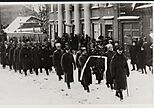
Julius Kuperjanov was given the Cross of Liberty after his death. His grave at the Raadi cemetery in Tartu was one of the few War of Independence monuments that survived the Soviet occupation. The monument was restored in 2008.
During the time Estonia was occupied by the Soviets (1940-1991), Kuperjanov's grave became a symbol of hope and freedom. People who loved Estonia would secretly gather there on important dates. They would light candles and place flowers to remember him. The KGB, the Soviet secret police, watched the grave and would arrest anyone who came to honor this national hero.
In 2009, a special stamp was released by Eesti Post to mark 90 years since Kuperjanov's death. Streets in Tartu, Valga, and Põltsamaa have also been named after him.
The Julius Kuperjanov Society
A group called the Kuperjanov Partisan Porgu Society was started on December 23, 1938. In 2010, this Society created a special medal in Lieutenant Kuperjanov's memory. This medal is given to people who have shown great honesty, purpose, and self-sacrifice for the good of the Estonian people.
So far, six people have received the Lieutenant Kuperjanov Medal:
- Julius Kuperjanov (awarded after his death)
- Johannes Soodla (a hero from the Battle of Paju and founder of the Kuperjanov Society, awarded after his death)
- Ülo Adamson (a leader of the Kuperjanov organization during the Soviet Occupation)
- Jüri Pertmann (a leader of the Kuperjanov organization during the Soviet Occupation)
- Villu Kibena (a leader of the Kuperjanov organization during Soviet Occupation)
- Artur Sirk (a well-known soldier from the War of Independence, awarded after his death)
Tartumaa Partisan Battalion Today
The Tartumaa Partisan Battalion, which Julius Kuperjanov led, was renamed in his honor. This battalion was brought back in 1992 after Estonia regained its independence. It is still an active part of the Estonian Defense Forces today, based in Võru.
See also
- Kuperjanov Infantry Battalion
- Estonian War of Independence


